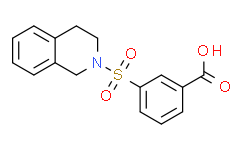| Cas No.: | 327092-81-9 |
| Chemical Name: | 3-((3,4-Dihydroisoquinolin-2(1H)-yl)sulfonyl)benzoic acid |
| Synonyms: | 3-((3,4-Dihydroisoquinolin-2(1H)-yl)sulfonyl)benzoic acid;3-(3,4-dihydro-1H-isoquinolin-2-ylsulfonyl)benzoic acid;3-(3,4-Dihydroisoquinolin-2(1H)-ylsulfonyl)benzoic acid;3-(3,4-Dihydroisoquinolin-2(1H)-ylsulphonyl)benzoic acid;006075;3-(2-1,2,3,4-tetrahydroisoquinolylsulfonyl)benzoic acid;3-(3,4-Dihydro-1H-isoquinoline-2-sulfonyl)-benzoic acid;AC1LEIZA;AC1Q73IW;CHEMBL1566492;SBB002606;ZERO |
| SMILES: | C1C2C(=CC=CC=2)CCN1S(C1=CC=CC(C(O)=O)=C1)(=O)=O |
| Formula: | C16H15NO4S |
| M.Wt: | 317.35960316658 |
| Purity: | >98% |
| Sotrage: | 2 years -20°C Powder, 2 weeks 4°C in DMSO, 6 months -80°C in DMSO Application |
| Description: | CRT0036521(AKR1C3-IN-1) is a potent, highly selective inhibitor of AKR1C3, with an IC50 of 13 nM. |
| Target: | IC50: 13 nM (AKR1C3)[1] |
| In Vitro: | AKR1C3-IN-1 shows less potent activities with 20.3±3.8 μM against AKR1C1 and >30 μM against AKR1C2 and AKR1C4. AKR1C3-IN-1 inhibits AKR1C3 activity (inhibiting PR-104H formation) with an IC50 of 0.027±0.002 μM[1]. |
| Kinase Assay: | A competitive fluorescence assay is used to measure AKR1C enzyme activity, where a nonfluorescent ketone probe (probe 5) selective for the AKR1C enzyme isoforms is reduced to a fluorescent alcohol in the presence of AKR1C enzyme and NADPH. Briefly, purified protein (2 μg/mL AKR1C1, 1 μg/mL AKR1C2, 2 μg/mL AKR1C3, and 5 μg/mL AKR1C4) are incubated with 40 μM probe 5, AKR1C3-IN-1, and 50 μM NADPH in an assay buffer of 10 mM MOPS (pH=7.2), 130 mM NaCl, 1 mM DTT, and 0.01% Triton-X-100 for 1 h at 37°C. The reaction is stopped by addition of 35 mM NaOH, and fluorescence is read in a SpectraMax M2 microplate reader at excitation/emission wavelengths of 420/510 nM. The compounds and known AKR1C3 inhibitors (flufenamic acid, indomethacin, naproxen, meclofenamic acid, S(+)-ibuprofen and flurbiprofen) are tested at multiple concentrations between 0.1 nM and 100 μM in 2% DMSO to generate AKR1C enzyme inhibition data. Compound IC50 values are calculated by fitting the inhibition data to a four-parameter logistic sigmoidal dose-response curve using Prism 5.02. |
| References: | [1]. Jamieson SM, et al. 3-(3,4-Dihydroisoquinolin-2(1H)-ylsulfonyl)benzoic Acids: highly potent and selective inhibitors of the type 5 17-β-hydroxysteroid dehydrogenase AKR1C3. J Med Chem. 2012 Sep 13;55(17):7746-58. |

 To enhance service speed and avoid tariff delays, we've opened a US warehouse. All US orders ship directly from our US facility.
To enhance service speed and avoid tariff delays, we've opened a US warehouse. All US orders ship directly from our US facility.




















